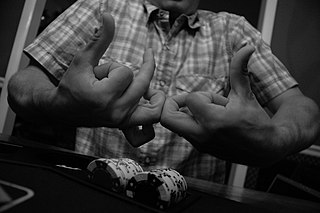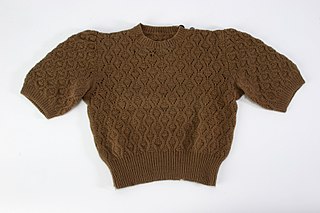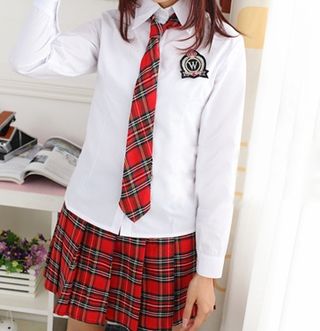
A uniform is a variety of costume worn by members of an organization while usually participating in that organization's activity. Modern uniforms are most often worn by armed forces and paramilitary organizations such as police, emergency services, security guards, in some workplaces and schools, and by inmates in prisons. In some countries, some other officials also wear uniforms in their duties; such is the case of the Commissioned Corps of the United States Public Health Service or the French prefects. For some organizations, such as police, it may be illegal for non-members to wear the uniform.

An apron is a garment that is worn over other clothing to cover the front of the body. They may have several purposes, typically as a functional accessory that protects clothes and skin from stains and marks. However, other types of aprons may be worn as a decoration, for hygienic reasons, as part of a uniform, or as protection from certain dangers such as acid, allergens or excessive heat. It can also be used at work stations to hold extra tools and pieces or protect from dust and unwanted materials.

A balaclava, also known as a monkey cap, balaclava helmet, ski mask or sheisty, is a form of cloth headgear designed to expose only part of the face, usually the eyes and mouth. Depending on style and how it is worn, only the eyes, mouth and nose, or just the front of the face are unprotected. Versions with enough of a full face opening may be rolled into a hat to cover the crown of the head or folded down as a collar around the neck. It is commonly used in alpine skiing and snowboarding.

A sweater or pullover, also called a jersey or jumper, is a piece of clothing, typically with long sleeves, made of knitted or crocheted material that covers the upper part of the body. When sleeveless, the garment is often called a slipover, tank top, or sweater vest.

The Bloods are a primarily African-American street gangs which was founded in Los Angeles, California. The gang is widely known for its rivalry with the Crips. It is identified by the red color worn by its members and by particular gang symbols, including distinctive hand signs.

A turban is a type of headwear based on cloth winding. Featuring many variations, it is worn as customary headwear by people of various cultures. Communities with prominent turban-wearing traditions can be found in the Indian subcontinent, Southeast Asia, the Middle East, the Balkans, the Caucasus, Central Asia, North Africa, West Africa, East Africa, and amongst some Turkic peoples in Russia.

Traditionally, a jersey is an item of knitted clothing, generally made of wool or cotton, with sleeves, worn as a pullover, as it does not open at the front, unlike a cardigan. It is usually close-fitting and machine knitted in contrast to a guernsey that is more often hand knit with a thicker yarn. The word is usually used interchangeably with sweater.
Criminal tattoos are classified in different ways. The meaning and histories of criminal tattoos vary from country to country, and they are commonly assumed to be associated with gang membership. They could also be a record of the wearer's personal history—such as their skills, specialties, accomplishments, incarceration, world view and/or means of personal expression. Tattoos have been empirically associated with deviance, personality disorders, and criminality. There is no direct correlation between tattoos and criminals, but we can observe the developed history of tattoos and their meanings in countries such as Australia, France, Italy, Japan, Russia, and the United States.

A Catholic school uniform in North America typically consists of a pleated and tartan skirt or jumper dress, Mary Jane or saddle shoes, a button-down shirt, and a sweater for girls, while boys' uniforms consist of a button-down shirt, a necktie, and dark pants. Actual school uniforms vary widely by location and individual school.
Japanese street fashion refers to a number of styles of contemporary modern clothing in Japan. Created from a mix of both local and foreign fashion brands, Japanese street fashions tend to have their own distinctive style, with some considered to be extreme and imaginations, with similarities to the haute couture styles seen on European catwalks.

A religious habit is a distinctive set of religious clothing worn by members of a religious order. Traditionally some plain garb recognizable as a religious habit has also been worn by those leading the religious eremitic and anchoritic life, although in their case without conformity to a particular uniform style.

Huipil is the most common traditional garment worn by indigenous women from central Mexico to Central America.
Sweater design is a specialization of fashion design in which knitted sweaters are designed to fulfill certain aesthetic, functional and commercial criteria. The designer typically considers factors such as the insulating power of the sweater ; the fashion of its colors, patterns, silhouette and style lines, particularly the neckline and waistline; the convenience and practicality of its cut; and in commercial design, the cost of its production and the profitability of its price point. Sweater designs are often published in books and knitting magazines. Sweater design is an old art, but continues to attract new designers such as Nicky Epstein and Meg Swansen.
A cheerleading uniform is a standardized outfit worn by cheerleaders during games and other events. These uniforms typically include the official colors and mascots of the school or team and are designed to make the wearer appear physically attractive.
People Nation is an alliance of street gangs generally associated with the Chicago area. They are rivals of the Folk Nation alliance of gangs.
Religious clothing is clothing which is worn in accordance with religious practice, tradition or significance to a faith group. It includes clerical clothing such as cassocks, and religious habit, robes, and other vestments. Accessories include hats, wedding rings, crucifixes, etc.

Gang colors include clothing, accessories, or tattoos of a specific color or colors that represent an affiliation to a specific gang or gang branch.

Colors are the insignia, or "patches", worn by motorcycle club members on cut-off vests to identify membership of their club and territorial location. Club patches have been worn by many different groups since the 1960s. They are regarded by many to symbolize an elite amongst motorcyclists and the style has been widely copied by other subcultures and commercialized.

Headgear, headwear, or headdress is any element of clothing which is worn on one's head, including hats, helmets, turbans and many other types. Headgear is worn for many purposes, including protection against the elements, decoration, or for religious or cultural reasons, including social conventions.

Fashion and clothing in the Philippines refers to the way the people of the Philippine society generally dress up at home, at work, travelling and during special occasions.















